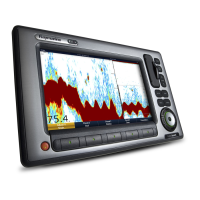1
2
1
3
2
Target (1) has been acquired (red circle overlay) using MARPA and is being tracked by your
radar. Speed and bearing of the target are shown and the target’s heading is shown as a thin
red line at 65°(2).
The tracked target has now moved into the previously set guard zone around your vessel and
has triggered the dangerous target alarm, seen on screen, and set off an audible alarm.
The alarm has been acknowledged and the target’s (1) (now overlaid with a red triangle to
note possible danger) closest point of approach (CPA) to your vessel is shown on screen as
0.376nm (3) and time to closest point of approach (TCPA) is 4 mins 20 secs (2).
An array of advanced operating modes are available via on-screen menus and soft-key functionality.
Safe emissions. Powerful enough to slice through atmospheric
clutter, Raymarine radars still comfortably meet International limits
Radio Frequency emissions – in fact, the energy absorbed from an
ordinary mobile phone can be several times greater than that from a
correctly installed Raymarine radar.
Installation. All radars work on line-of-sight principles so although
antennas could theoretically be fitted almost anywhere, unobstructed
and parallel to the water line is better.
Interference resistance. Raymarine radars use interference
rejection technology to resist signal interference from other vessels'
transmissions as well as close proximity objects already fitted to the
boat.
256 colour resolution. helps define the strength of target returns
and highlights targets that could be hidden within clutter.
Pulsed magnetron vs broadband (FMCW) radar
technology. Broadband (FMCW) radars typically emit low levels of
energy, resulting in loss of ultimate performance in conditions of fog,
rain, spray and snow, and limiting target detection at longer ranges.
Raymarine pulsed magnetron radars combine low average energy
with high peak powers allowing the radar to detect targets at greater
ranges, and to punch through adverse weather conditions ensuring
targets are identified.
RACON and SART. Raymarine radar antennas also trigger
RACON beacons and home in on signals from Search And Rescue
Transponders.
Important Information
Track targets. Not everything transmits AIS! Using MARPA* (mini-automatic radar plotting aid) allows you to identify vessel, speed, bearing, closest point of
approach (CPA) and time to closest point of approach (TCPA), dangerous/proximity alarms, overlay AIS info for further target clarification.
Racon and SART
Raymarine radar antennas also
trigger RACON beacons and
pick up signals from Search And
Rescue Transponders.
Chart Overlay
Radar can be overlaid onto a
chart, as shown in the left hand
image, to clearly identify targets.
Note the superior target clarity
and separation on the submarine
barrier to the left of both screens.
* For the best radar overlay and MARPA performance fit a smart heading sensor or an SPX autopilot course computer.
RADAR ANTENNAS 61

